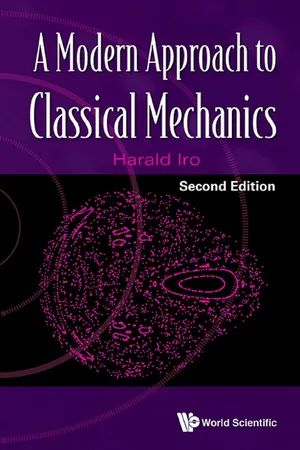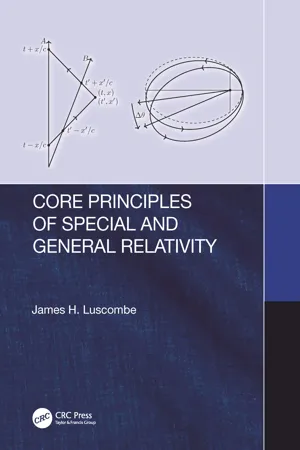Physics
Transformation Between Coordinate Systems
Transformation between coordinate systems refers to the process of converting the coordinates of a point from one system to another. This is often done using mathematical equations or algorithms that account for differences in orientation, scale, and origin between the two coordinate systems. In physics, this transformation is crucial for analyzing and describing physical phenomena in different reference frames.
Written by Perlego with AI-assistance
Related key terms
Related key terms
1 of 4
Related key terms
1 of 3
5 Key excerpts on "Transformation Between Coordinate Systems"
- eBook - ePub
- Harald Iro(Author)
- 2015(Publication Date)
- WSPC(Publisher)
Conceptually, a frame of reference comprises of a point of reference 1, together with devices for determining the position of some event with respect to the point of reference, and appropriately installed clocks for determining the time of occurrence of the event at any position 2. The mathematical counterpart of such a reference frame is a coordinate system (origin and axes) and a time scale, which together allow us to describe, for example, the motion of a particle at any time – its position r at time t, as well as its rate of change with time by and. In any particular reference frame, different coordinate systems may be chosen (e.g. Cartesian or spherical coordinates). When relating the observations of physical quantities in two different frames of reference, one has to state how to compare them: what do the views in the two systems have in common? A fundamental assumption of nonrelativistic, classical physics enters here: that the distance between two physically distinguished positions – e.g. between two bodies – is independent of the reference frame 3. However, changing the reference frame may also affect physical quantities, as in the example of particle collision the scattering angle or the velocity observed in the center of mass frame and in the laboratory frame. A change of coordinate system within a given frame, has, of course, no influence on the physical processes; only the (mathematical) description is affected by the choice 4. The coordinate system is often considered to be the reference frame, but strictly speaking one should distinguish between these two notions. Of course, a change of reference frame is accompanied by a coordinate transformation (but not, in general, vice versa) - Christopher Jekeli(Author)
- 2023(Publication Date)
- De Gruyter(Publisher)
1 Coordinate Frames and Transformations1.1 Introduction
When describing locations of points on or near the Earth’s surface, we most naturally turn to a system of coordinates. Although one could imagine devising a relational or synthetic data base to describe the whereabouts of objects and places, it is of necessity that we assign an algebraic system of coordinates if we wish to go beyond mere location information and obtain measures of distance, area, volume, and direction. And, likewise with navigation, we need to define a coordinate system in which we can measure our progress and easily determine our course and destination. There are several coordinate systems from which to choose. Each has its own unique utility depending on the particular application in a particular discipline. In geodesy we deal with determining positions, or the mathematics of map projections, or the navigation of a vehicle, or its guidance along a predefined path. Specific coordinate systems must be defined in each case.Figure 1.1: Cartesian coordinates of vector, x , and unit vectors,e j.We will be concerned primarily with the Cartesian, or rectangular, coordinates, whose axes are mutually orthogonal by definition, but this triad of axes, as shown in Figure 1.1 , may assume a variety of orientations in space. The axes of any coordinate system are designated here generally in numerical order as the 1-axis, the 2-axis, and the 3-axis. Each system of axes is defined to be right-handed in the sense that a90 ∘counterclockwise (positive) rotation about the 1-axis, as viewed along the 1-axis toward the origin, rotates the 2-axis into the 3-axis. Also, a90 ∘rotation about the 2-axis rotates the 3-axis into the 1-axis; and a90 ∘rotation about the 3-axis rotates the 1-axis into the 2-axis.We will denote the set of Cartesian coordinates by a lowercase subscripted letter, such asx j,j = 1 , 2 , 3. The corresponding bold letter, x , will denote a vector withx jas components (see Figure 1.1 ). Also shown in Figure 1.1 is a set of special vectors, called unit vectors, denoted bye j,j = 1 , 2 , 3. Each unit vector has only one non-zero component, namely the jth component equals 1; that is,e j- eBook - ePub
- Ranjan Parekh(Author)
- 2019(Publication Date)
- CRC Press(Publisher)
42D Transformations
4.1 Introduction
Two-dimensional transformations enable us to change the location, orientation and shapes of splines in 2D space. These transformations are translation, rotation, scaling, reflection, and shear (Hearn and Baker, 1996) applied individually or in combination of two or more. Given known coordinates of a point, each of these transformations is represented by a matrix which when multiplied to the original coordinates gives us a new set of coordinates. An entire spline is transformed by transforming all the points of the spline. In the following sections, the transformation matrices will be derived and applied to original points to give new points. Before that, however, we introduce the concept of homogeneous coordinates, which enable us to represent all types of transformation in a homogeneous or uniform manner. To calculate the coordinates and directions, we use a 2D right-handed coordinate system. Although, we have been using coordinates of points from Chapter 1 , now we establish a formal definition of a 2D coordinate system as transformation requires a rigorous understanding of how distances and angles are calculated and how they are changed during the course of transformation operations.The concept of a 2D Cartesian coordinate system is attributed to the 17th century French mathematician Rene Descartes and is widely used to measure location of a point on a 2D plane from a reference point called the origin. The location is represented as a pair of signed distances measured along two mutually perpendicular lines called axes meeting at the origin. Sometimes, the axes are also referred to as the primary axes or principal axes to distinguish them from other lines parallel to them. The first axis is usually depicted as a number line along the horizontal direction and called the X -axis while the second axis as a number line along the vertical direction and called the Y -axis (see Figure 4.1 ). Distance of a point on the plane measured along the X -axis from the origin is called the x -coordinate or abscissa and distance along the Y -axis is called the y -coordinate or ordinate. The location of a point is, therefore, represented as a pair of ordered numbers (x , y ) called its coordinates. Since all distances are measured from the origin, the origin itself has coordinates (0, 0) and denoted by O . In most cases, the origin is visualized as a point in the center of the paper with the x -coordinates being measured positive toward the right and negative toward the left, and the y -coordinates being positive toward the top and negative toward the bottom. However in the context of a computer display, the origin is usually located at the lower-left corner of the screen with the axes toward the right and top, while for some cases the origin is also depicted at the upper left of the screen with the axes toward the right and bottom of the screen. Since the axes are perpendicular to each other the system is often referred to as rectangular coordinate system or orthogonal coordinate system. Numbers measured along the axes can in general be floating point numbers although in some cases like measuring pixel dimensions of images on screen, the numbers are thought to be only integers. The two axes divide the plane into four parts called quadrants such that in the first quadrant (Q1) both x and y are positive, in the second quadrant (Q2), x is negative, in the third quadrant (Q3) both are negative, and in the fourth quadrant (Q4), y is negative. To fix the orientation of the axes with respect to one another a convention called the right-hand rule is often used. If the first finger and the second finger of the right-hand are stretched out at right angles to each other then the direction from the hand to the tip of the finger would represent the positive x and positive y - eBook - ePub
Analytical Geometry
Two Dimensions
- Sibdas Karmakar, Samiran Karmakar(Authors)
- 2022(Publication Date)
- CRC Press(Publisher)
Chapter 1 Transformation of Rectangular Cartesian Coordinates1.1 Introduction
In analytical geometry the position of a point is determined with the help of a coordinate system, for which we require an arbitrarily chosen origin and two straight lines intersecting at the origin. This follows that the coordinates of a point are different for different sets of axes. That is the coordinates of a point are relative. This may happen when the origin is shifted to a point keeping the directions of the axes unchanged or when the axes are rotated through an angle keeping the origin unaltered. The former is called translation and the later is called rotation. The coordinates of any point may also be affected by a combination of these two, called a rigid motion or orthogonal transformation.In this chapter, we shall establish formulas corresponding to the above transformations.1.2 Coordinate Transformation Formulas
1.2.1 Translation (or transformation by translation of axes)
If the origin be shifted to any other point without changing the directions of coordinate axes, the result is known as translation.Let (x, y) be the coordinates of P with respect to a rectangular axes OX and OY and (x′, y′) be its coordinates with respect to a new set of axes O′X′ and O′Y′ which are parallel to the original axes O′X′ and O′Y′ respectively.Let (a, b) be the coordinates of the new origin O′ with respect to the old axes OX and OY. PM is perpendicular to OX. It meets O′X′ at N. O′L is perpendicular to OX. Therefore, from the Figure 1.1 ,O M = x , P M = y ,O ′N =x ′, N P =y ′, O L = a ,O ′L = b .∴ x = O M = O L + L M =O ′N + O L =x ′+ aa n d y = P M = P N + N M = P N +O ′L =y ′+ b .Figure 1.1Hence the required translation formulas are given by - James Luscombe(Author)
- 2018(Publication Date)
- CRC Press(Publisher)
principle of covariance , the requirement that the equations of physics adhere to the principle of relativity by having the same mathematical form in all reference frames.Coordinate transformations in SR must be linear . All inertial observers agree that the spacetime trajectories (worldlines ) of free particles are straight (see Section 1.4 ). Coordinate transformations between IRFs must be such as to map straight lines in spacetime onto straight lines so as to preserve the law of inertia. Only homogeneous, linear transformations map straight lines onto straight lines, where both lines pass through the same origin of the coordinate system. We’ll work through some examples to see how inertial frames can differ and yet be equivalent.1.2.4.1BoostsFigure 1.1 shows frames S and S ′ with origins displaced by vector R , where the coordinate axes are parallel. We will of course be interested in the case of relative motion whereR = R ( t )is time dependent, but for now let R be fixed. Any transformation between frames with parallel axes (as in Fig. 1.1 ) is called a boost .Figure 1.1 Frames S and S ′ in boost configuration: coordinate axes are parallel.In Fig. 1.1 the same point in space, denoted with an asterisk, is referenced by vectors r and r ′, with(law of vector addition). This simple (linear) coordinate transformation can be “inverted” by interchanging primed and unprimed quantities and lettingr ′= r − RR → − R,r =. That rule will stand us in good stead with linear coordinate transformations: Interchange primed and unprimed quantities and reverse the transformation parameter (velocity, angle, etc.). Suppose S is an IRF, i.e., a frame in which a free particle is unaccelerated,r ′+ R. By differentiating the transformation equation we conclude thatr ¨= 0. If S is an IRF, so is S ′ when it’s connected to S by a displacement. There is no unique origin for IRFs= 0r ¨′
Index pages curate the most relevant extracts from our library of academic textbooks. They’ve been created using an in-house natural language model (NLM), each adding context and meaning to key research topics.
Explore more topic indexes
Explore more topic indexes
1 of 6
Explore more topic indexes
1 of 4




